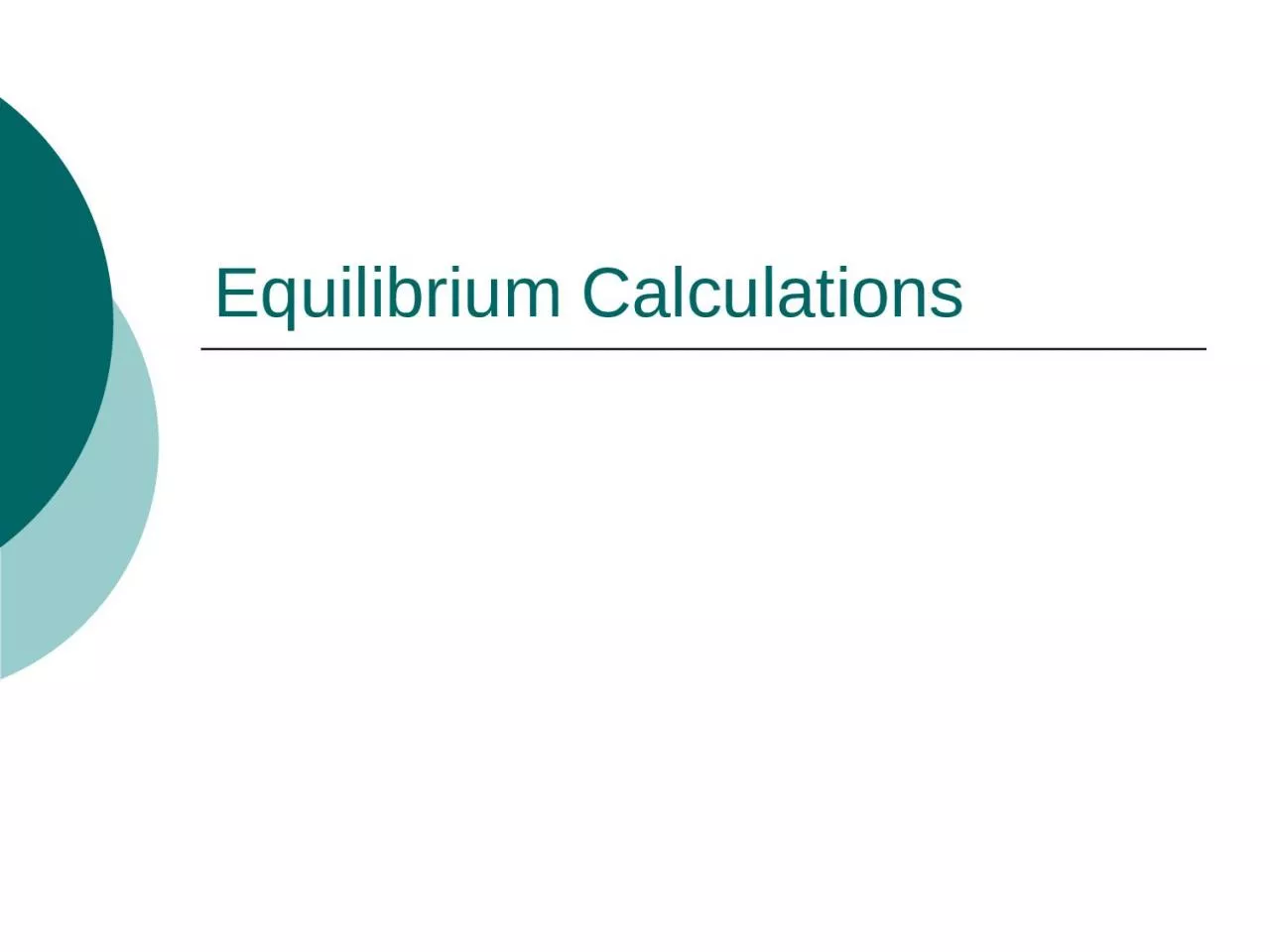

Law of chemical equilibrium For an equilibrium a A b B c C d D K C c D d A a B b K is the equilibrium constant for that reaction The mean concentration in molarity ID: 1026551
Download Presentation The PPT/PDF document "Equilibrium Calculations" is the property of its rightful owner. Permission is granted to download and print the materials on this web site for personal, non-commercial use only, and to display it on your personal computer provided you do not modify the materials and that you retain all copyright notices contained in the materials. By downloading content from our website, you accept the terms of this agreement.
1. Equilibrium Calculations
2. Law of chemical equilibriumFor an equilibriuma A + b B c C + d DK = [C]c[D]d [A]a[B]bK is the equilibrium constant for that reaction.The [ ] mean concentration in molarity
3. Determine the equilibrium expressionFor the following:Br2(g) ⇌ 2Br(g)N2(g) + 3H2(g) ⇌ 2NH3(g)H2 (g) + Br2(g) ⇌ 2 HBr(g)HCN(aq) ⇌ H+(aq) + CN-(aq)
4. Problem2NH3 (g) N2 (g) + 3H2 (g) Calculate the equilibrium constant for the above reaction if it comes to equilibrium with the following concentrations: N2 = .59 M, H2 =3.1 M, and NH3 = 1.03 M
5. AnswerK = [N2][H2]3 [NH3]2K = [.59][3.1]3 [1.03]2K = 17
6. Equilibrium by phaseEquilibrium depends on the concentration of the reactants.We can calculate the concentration of a gas or of anything dissolved (aqueous).Insoluble solids or liquids won’t have a concentration. They in essence are removed from the equilibrium.
7. So using thatWhat would the equilibrium expression look like for the following reaction?2 H2O2(l) 2 H2O(l) + O2(g)We ignore the liquids (and solids).K = [O2]
8. Water2 H2O(l) ⇌ H3O+ (aq) + OH- (aq)Kw = [OH-] [H3O+ ] Kw is the equilibrium constant for water, it equals 1 x 10-14 MWe have already used the equation
9. Another problem2 SO2 (g) +O2 (g) 2 SO3 (g) K = 4.34, for the above reaction. Calculate the concentration of SO3 if the SO2 = .28 M and O2 = .43 M at equilibrium.
10. AnswerK = [SO3] 2 [SO2]2 [O2] 4.34 = [SO3]2 [.28]2[.43][SO3] = .38 M
11. Reaction Quotient , QThe reaction quotient, Q, gives us a value of current concentrations of all chemicals before they complete reacting towards equilibrium.It is calculated the same way as K except you use current concentrations. Comparing the Q value to the K value allows you to determine which way the reaction will shift.
12. K and Q valuesK and Q are calculated by products over reactants. Larger values mean higher products, smaller mean higher reactants.If K is larger than Q, it means that Q has a higher concentration of reactants so the reaction will shift to the right.If K is smaller than Q, it means that Q has a higher concentration of products so the reaction will shift to the left.If K equals Q you are at equilibrium, no shift
13. Easy way to rememberGreater than, less than signs are an arrow!!!Put K first, then Q and determine which is larger.K > Q, shift rightK < Q, shift leftK = Q, No shift
14. Q problemThe K is .060 for the reaction: N2 + 3 H2 ⇌2 NH3Calculate Q and determine which way the reaction will shift[N2] (M)[H2] (M)[NH3](M)Case 11.0x10-52.0x10-31.0x10-3Case 21.5x10-53.54x10-12.0x10-4Case 35.01.0x10-21.0x10-4
15. AnswerQ = [NH3]2 [N2][H2]3Case 1, Q = 1.25 x107K < Q, reaction shifts leftCase 2, Q = .060K = Q, equilibriumCase 3, Q = .002K> Q, reaction shifts right
16. Solution EquilibriumAll dissociations we have done are equilibriums.Before we simply stated something was soluble or insoluble. Actually everything dissolves to some extent, and some dissolved substance fall out of solution.Higher concentrations force more solute to fall out of solution.So there is a maximum concentration of solute a solution can hold (saturation)
17. Solution equilibriumFor Example:Lead (II) BromidePbBr2 (s) Pb2+ (aq) + 2 Br-(aq)What would the equilibrium expression look like?Ksp = [Pb2+ ][Br-]2Equilibrium constants for dissociations are called solubility products, and are denoted by Ksp.
18. Cont.The Ksp value for PbBr2 is 5.0 x 10-6.PbBr2 (s) Pb2+ (aq) + 2 Br-(aq)Say the maximum moles of PbBr2 that can dissolve is x moles per 1L. Using the balanced equation, I will have x mole/L of Pb2+ and 2x mole/L of Br-So 5.0 x 10-6= x (2x)25.0 x 10-6= 4x3x=.011 M This is the solubility, or maximum amount of solute, PbBr2, that will dissolve.[Pb2+ ] = .011 M 2x = [Br-]= .022 M
19. This means A solution of PbBr2 would be saturated with [PbBr2] = .011 MAfter I reach that level, no more will dissolve.This is a very low concentration, so we say the is compound is insoluble.In the solution, the ion concentrations would be [Pb2+] = .011 M [Br-]= .022 M
20. ProblemsCalculate the solubility and saturation concentrations of ions in aluminum hydroxide Ksp = 5.0 x10 -33, and Barium sulfate Ksp = 1.4 x10 -14
21. AnswerAl(OH)3 Al3+ (aq) + 3 OH-(aq)Ksp = [Al3+ ][OH-]35.0x10-33 = x (3x)3x = 3.7x10-9 M (solubility)[Al3+ ]= 3.7x10-9 M3x = [OH-] = 1.1 x10-8 M
22. AnswerBaSO4 Ba2+ (aq) + SO42-(aq)Ksp = [Ba2+ ][SO42-]1.4x10-14 = x (x)x = 1.2 x10-7 M (solubility)[Ba2+]= 1.2 x10-7 M [SO42-] = 1.2 x10-7 M